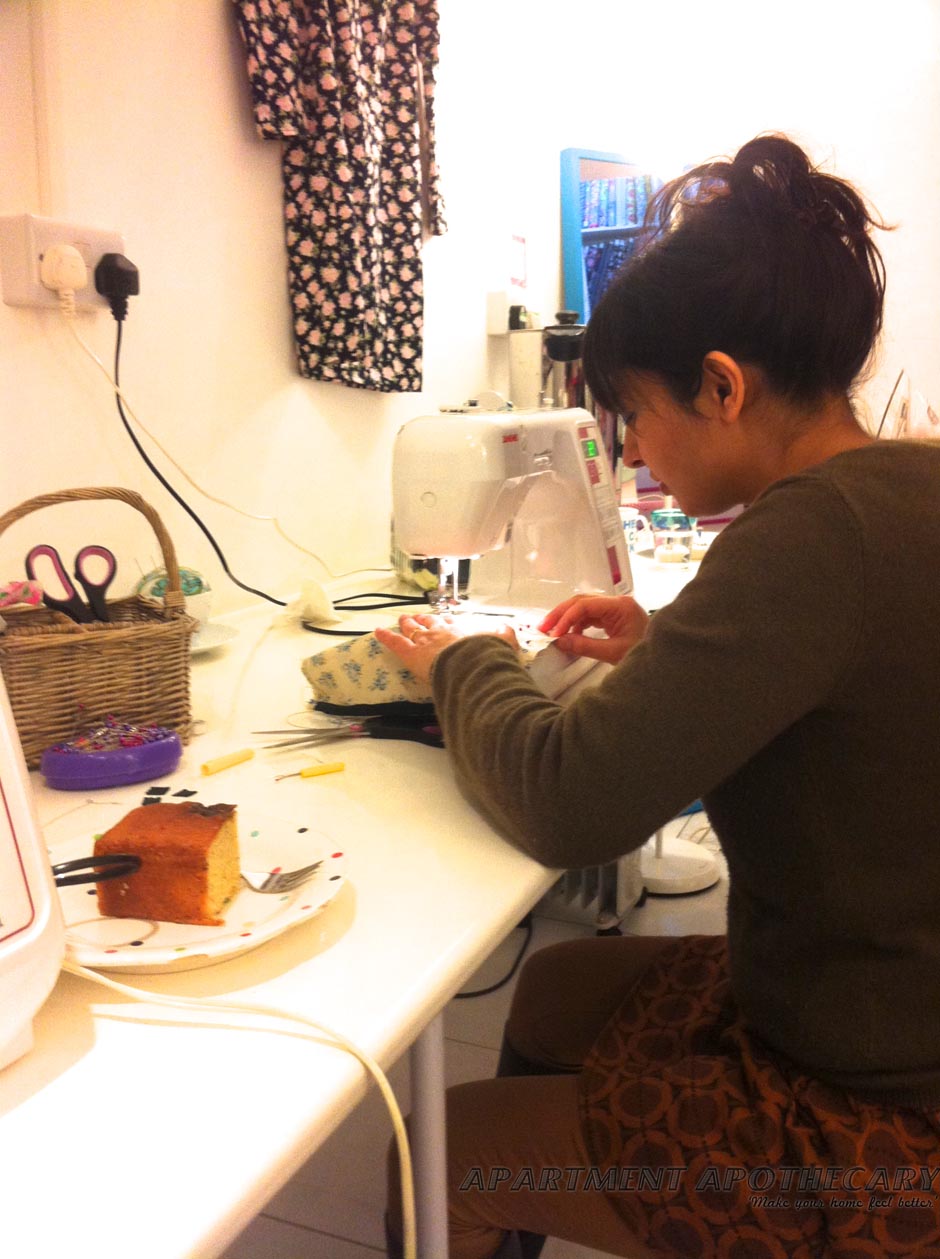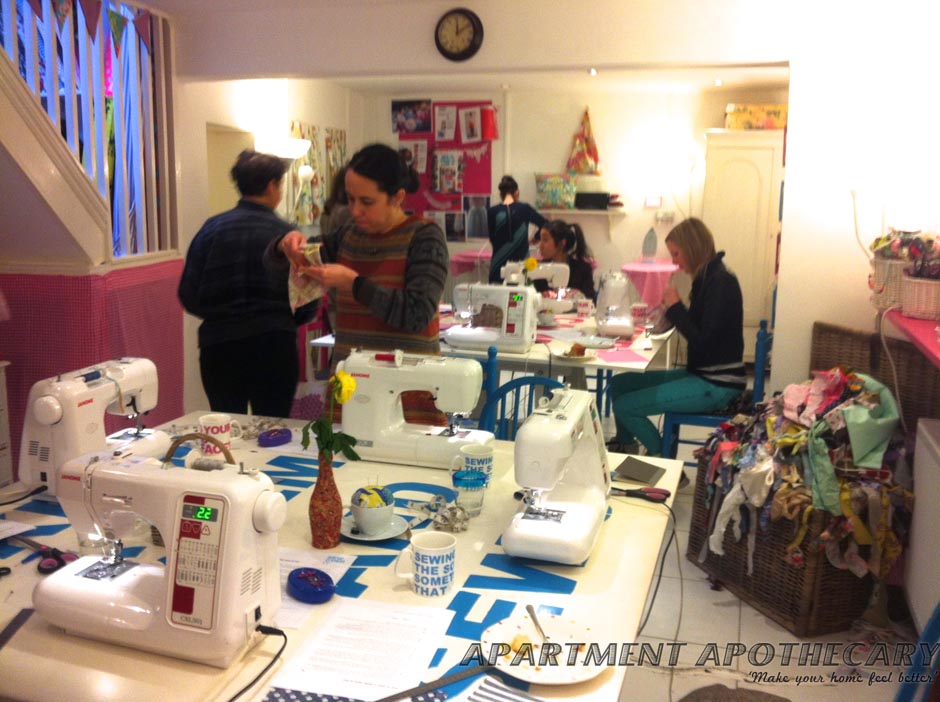Did anyone see the Great British Sewing Bee last night? I’m very excited about it and feel full of motivation to push my new hobby further (especially as Patrick Grant is involved!). So, I have a new sewing project to share today…
This project is in honour of my friend Betty and her baby bump. I am making a present for her baby shower and if you are wondering what a cot tidy is, it’s an excuse for me to indulge my addiction to Liberty fabric and make something delightful for my wonderful friend (and hopefully she’ll find it useful too!).
You will need:
1. Lightweight cotton fabric: Two 47cm x 38cm pieces for the back and front, two 46cm x 28cm pieces for the pocket and sixteen 4cm x 20cm strips for the four handles (or use ribbon as this is the bit that takes the longest). I’ve used Phoebe and Poppy and Daisy prints from Liberty.
2. Medium weight interfacing – It can be ironed on to your fabric to make it stiffer and gives it shape and form. I bought it from John Lewis. You will need exactly the same amount of interfacing as material.
3. 50cm of double folded 25mm bias binding, which I bought from John Lewis.
4. Sewing machine, fabric scissors and/or cutting board and rotary cutter, pins, chalk, cotton, needle, button hole foot for sewing machine.
5. Self cover buttons that you can buy from Sew Over It.
Tutorial
a) Cutting your pattern:

1. Press your material.

2. Cut your pieces of interfacing, using scissors or a rotary cutter: Two 47cm x 38cm pieces for the back and front, two 46cm x 28cm pieces for the pocket and sixteen 4cm x 20cm strips for the four handles. These will act as your pattern.

3. Place your interfacing pieces onto the wrong side of your fabric, one at a time, and iron on (using the instructions in the packet). Cut each piece out either with scissors or a rotary cutter on a cutting board.
b) Make and bind the pocket:

4. Pin three sides of your two pocket pieces together, right sides together (interfacing facing outwards), leaving the bottom open.

5. Sew the sides and the top of the pocket together leaving one long side (which will be the bottom) open.

6. Turn your pocket inside out. I have used a different fabric for the inside and outside of the pocket.

7. Unfold one side of your binding and line the top edge with the edge of the top of your pocket (this is the sewn, neat edge of your pocket.)

8. Sew along the first crease of the binding.

9. Fold the binding over the edge of your pocket and press and pin it.

10. Now, sew the binding on the top side of the pocket so that it catches the back of the binding on the back of the pocket.
c) Attaching the pocket to the front piece of the cot tidy:

11. Pin your pocket to the front piece of your cot tidy (the back piece should be set aside still), leaving at least an inch either side to allow for a seam allowance and to give your pocket some volume.

12. Pin the bottom corners of the pockets carefully to pinch in the volume of the pocket.

13. Divide your pocket in half and draw a straight line top to bottom with tailors’ chalk.

14. Sew a couple of lines of topstitch up the centre of the pocket to divide it into two. Now set this piece aside.
d) Making the tabs to attach the cot tidy to the bar of the cot:

15. Sew the right sides of each tab together, with as little seam allowance as possible. There are eight of these to do so patience is needed!

16. Turn each tab outside in using a pencil to push it out.
e) Putting all the pieces together:

17. Press a 1cm seam on the back piece of your cot tidy but don’t sew it yet.

18. Sew each tab on the wrong side of the back piece, with the pressed seam. Use thread in your bobbin that you want to be seen on the back of your cot tidy.

19. It should look like this once you’ve sewn all the tabs on.

20. Press a 0.5cm seam along the front piece of the cot tidy. Now, pin the front of the cot tidy (with the pocket already attached to it) wrong side out to the back of the cot tidy, which should also be be wrong side out.

21. Sew along both sides and bottom of the cot tidy. Leave the top, where the tabs are, open so you can turn it inside out.

22. Sew topstitch along the top of the cot tidy, securing the tabs in place and leaving a neat edge.
f) Making the buttons:

23. Place the top side of the button on the wrong side of the fabric, draw round it and then cut out leaving 1cm all the way round.

24. Do a running stitch round the outside of the circle and leave the two ends of the threads poking out.

25. Place the top side of the button inside the fabric and pull the two ends of the thread tight so the fabric gathers in and then push the bottom side of the button in.

26. Pop the back on the button.

27. Perhaps the most satisfying bit of the whole process!

28. Using a button hole foot on your sewing machine make a button hole on your front tabs and sew on your fabric covered buttons to your back tabs. Then, you’re done!

The back.

The front.

Inside the pockets is the contrasting fabric.

Its purpose is to hang over the side of a cot to hold books, toys, rattles whilst baby sleeps.

Maisie the mouse is not included, I’m afraid!
Happy baby shower, Betty, and happy sewing everyone else!
Katy x

















































































